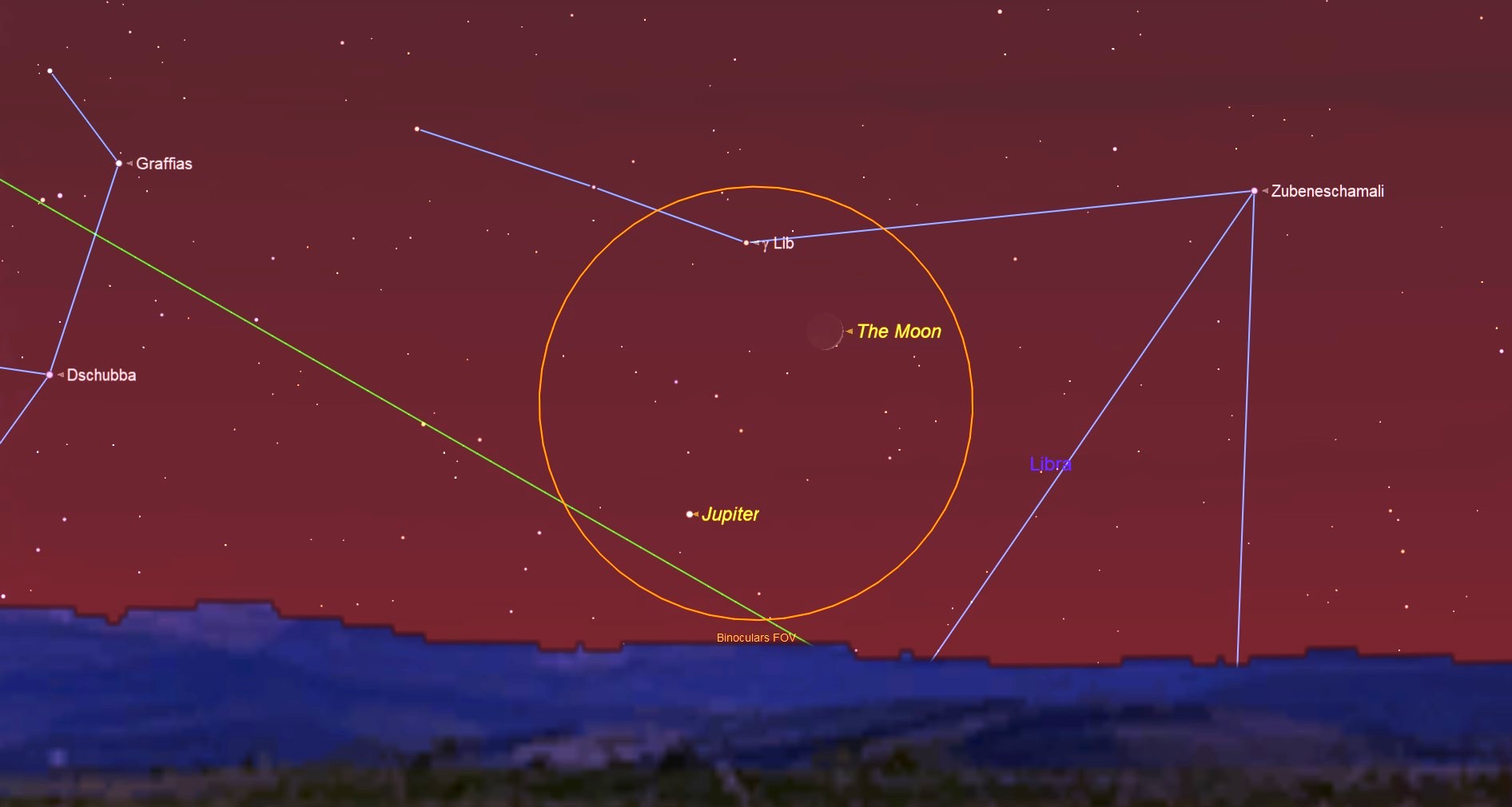Jupiter's Last Evening Dance with the Moon Comes Tonight

Jupiter will soon end its brilliant yearlong showing in the evening sky. October is the last full month that we'll see the giant planet, and this evening, it will engage in a rendezvous with a slender crescent moon. The moon will pass some 3 degrees to the upper right of the solar system's largest planet.
Indeed, the moon itself will appear so thin that, initially, it may be rather hard to detect in the sun's afterglow. The waxing moon will be 9 percent illuminated and just under three days past new phase. The planet and moon will set about 1 1/2 hours after sunset.
To enhance your chances of seeing both moon and planet, make sure that your viewing site has a very clear and unobstructed view toward the west-southwest part of the sky. A half hour after sunset, the moon and Jupiter will hang about a dozen degrees above the western horizon. As we have pointed out on many other occasions, 10 degrees is roughly equivalent to the apparent width of your clenched fist held at arm's length. So, about half an hour after sunset, the moon will appear just over one fist above the horizon. Jupiter, will appear below the slender sliver as a brilliant white dot against the bright twilight background. [Full Moon Calendar: When to See the Next Full Moon]
You can increase your chances of picking up both the moon and Jupiter right after sunset by first scanning the western sky with binoculars. Once you sight the two bodies, getting a glimpse of the pair with your unaided eyes should be easier, especially as the twilight deepens.
Farewell until the winter
After tonight, the moon and Jupiter will go their separate ways, with the moon moving off to the east while the "king of the planets" keeps getting lower each evening. During the final week of October, Jupiter will pass near to Mercury. But that will be a very challenging pairing to observe. Odds are that the very low altitude and bright-sky backdrop will prevent you from seeing one or both planets, but if you do get even a fleeting glimpse of them, you will have really accomplished something.
By Halloween, you can pretty much say goodbye to Jupiter as an evening object, as the sunset glow will rapidly swallow up the planet.
Jupiter will be in conjunction with the sun — on the opposite side of the star from Earth — on Nov. 26th. The giant planet will not reappear again until sometime in mid or late December, when it will transition to the early morning sky and again draw close to Mercury.
Breaking space news, the latest updates on rocket launches, skywatching events and more!
Joe Rao serves as an instructor and guest lecturer at New York's Hayden Planetarium. He writes about astronomy for Natural History magazine, the Farmers' Almanac and other publications, and he is also an on-camera meteorologist for Verizon FiOS1 News in New York's Lower Hudson Valley. Follow us on Twitter @Spacedotcom and on Facebook. Original article on Space.com.

Joe Rao is Space.com's skywatching columnist, as well as a veteran meteorologist and eclipse chaser who also serves as an instructor and guest lecturer at New York's Hayden Planetarium. He writes about astronomy for Natural History magazine, Sky & Telescope and other publications. Joe is an 8-time Emmy-nominated meteorologist who served the Putnam Valley region of New York for over 21 years. You can find him on Twitter and YouTube tracking lunar and solar eclipses, meteor showers and more. To find out Joe's latest project, visit him on Twitter.
